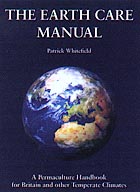The Earth Care Manual
Sustainability is the Holy Grail for all those interested in the harmony of man and planet. DAVID FLEMING is thrilled to discover a new book that shows us how to achieve it.


The Earth Care Manual: A Permaculture Handbook for Britain and Other Temperate Climates
(Permanent Publications, £34.95)
If chickens forage in your orchard in the autumn and winter, and corn marigold, fleabane and ox-eye daisy grow there in the spring and summer, you are unlikely to be troubled by pests and diseases on your apples.
From the bugs' point of view, chickens are ferocious. They spell trouble for codling moth, apple-, plum- and gooseberry-sawfly, winter moth, scab, pear mite, slugworm, raspberry beetle and cane midge. And they can also warm up your greenhouse, clear vegetable beds of slugs and seeds ready for cultivation, save you the trouble of digging, pick the lice off pigs, and clear the ground of a coppiced woodland of the brassy beetle.
Oh, and the most lethal chicken for the brassy beetle is the Ixworth Cross.
That's the stuff: there are no generalities here. Patrick Whitefield's book is a storm of well-presented, well-tested, invaluable detail. This is a book for anybody who wants to make ingenious and prodigious use of their land. And it will be a turning-point in the story of permaculture.
Permaculture is about careful, joined-up thinking applied to land, food, water and housing. The local ecology is arranged so that cause-and-effect flows through the system, making it immensely productive; the skilled attention and detail which is possible on small-scale holdings can produce yields of four (or more) times that of a typical farm.
Exquisite houses, the beauty of Nature, and how to get the most from your life, straight to your inbox.
Why, then, do we need the large farms of industrial agriculture? And why are large farms claimed to be efficient? Well, 'efficiency', in this sense refers to efficiency in the use of labour, not in the productivity of land, and if there really were the intention to produce more food, it would be small-scale detail, and not industrial agriculture, which would be the focus of effort.
The snag, of course, is that it does need labour: the labour does not have to be working all the time, but it needs to be about, and it needs to have an eye for detail: permaculture systems want someone to inhabit them. And yet, is a highly productive, sustainable local agriculture, managed by skilled independent people who have learned how to think, really a snag? Whitefield is a generous teacher. He tells us how to design a permaculture system, how to map it using instruments which we can make for ourselves, how to combine crops which help each other? and how to save ourselves work.
Some heartening new thinking is coming along on the art of growing food; enlightened agriculture, agro-ecology and sustainable intensification all see it as a connected system.
Permaculture can now claim to be discovering those connections with persistence and with perhaps more brilliance than any of them?and Mr Whitefield explains precisely what that means.
Order The Earth Care Manual: A Permaculture Handbook for Britain and Other Temperate Climates today
Country Life is unlike any other magazine: the only glossy weekly on the newsstand and the only magazine that has been guest-edited by His Majesty The King not once, but twice. It is a celebration of modern rural life and all its diverse joys and pleasures — that was first published in Queen Victoria's Diamond Jubilee year. Our eclectic mixture of witty and informative content — from the most up-to-date property news and commentary and a coveted glimpse inside some of the UK's best houses and gardens, to gardening, the arts and interior design, written by experts in their field — still cannot be found in print or online, anywhere else.
-
 Child stars, Prince and nursery rhymes: It's the Country Life Quiz of the Day, December 5, 2025
Child stars, Prince and nursery rhymes: It's the Country Life Quiz of the Day, December 5, 2025It's all in today's quiz.
-
 ‘Calf’s brains have a bland, gentle richness that soothes and cossets': Tom Parker Bowles on the joys of eating offal
‘Calf’s brains have a bland, gentle richness that soothes and cossets': Tom Parker Bowles on the joys of eating offalEating offal it is more sinned against than sinning, but it offers the ultimate in magnificent, fully immersive eating.
